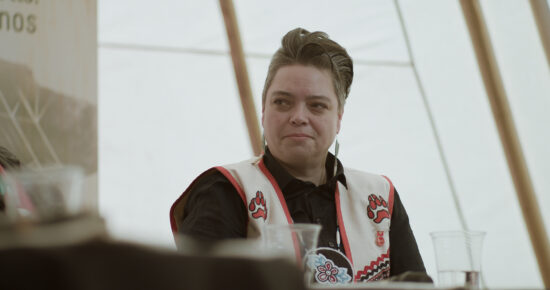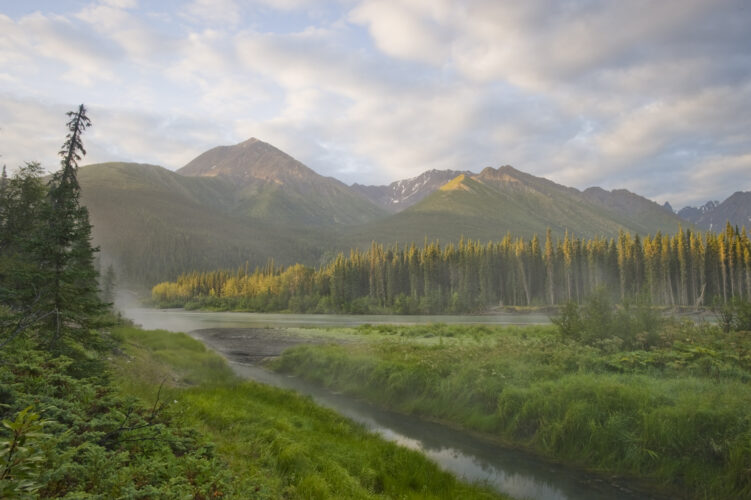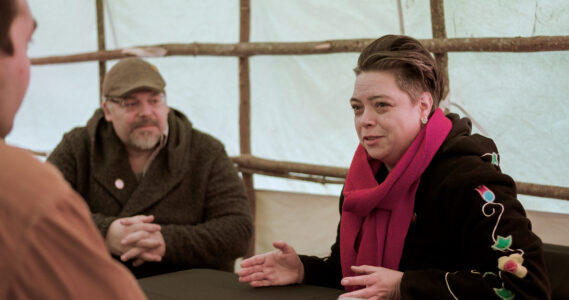Leader of Indigenous-Led Conservation and Land Stewardship Efforts in Canada Wins 2023 Bright Award
It was a frigid April morning in Québec and 11-year-old Valérie Courtois was on a small boat, fishing for landlocked salmon with her grandfather. As she heaved a net from the icy waters of Lac St. Jean—the body of water her Innu community has long called Peikuakami—she heard her grandfather laughing from the back of the boat. She spun around, sure that he was making fun of her technique. Instead, she was met with his joyful smile.
“I am laughing with happiness,” Courtois remembers her grandfather saying. “You are in your element. I really hope you will continue to do this throughout your life – to be in nature, out on the water, fishing, and being Innu.”

Today, as one of North America’s leaders in the movement for Indigenous-led conservation and land stewardship, Courtois is not only living out her grandfather’s wish for her, she is helping thousands of other Indigenous Nations in Canada (often referred to as First Nations) realize the same dream—all while helping protect swaths of land and water across Canada.
In recognition of her decades of work making sure Indigenous Peoples in Canada are holding the pen when lines are drawn on the map and managing and stewarding their lands and waters, Courtois was selected as the 2023 winner of Stanford University’s highest environmental prize, the Bright Award for Environmental Sustainability. The annual award was established by a gift from Stanford Law School (SLS) alumnus and lifelong conservationist Raymond E. Bright, JD ’59, who passed away in 2011. The winner is selected annually from one of 10 rotating regions worldwide based on recommendations from regional consultants and a nominating committee composed of SLS faculty and students, and led by Stanford Law’s Barton H. Thompson, Jr., the Robert E. Paradise Professor in Natural Resources Law. Courtois will receive the award at an October 2, 2023 ceremony at Stanford.

Since 2013, Courtois has served as the founding executive director of the Indigenous Leadership Initiative (ILI), which supports Indigenous Nations in caring for their lands and waters. ILI partners with dozens of First Nations within Canada and advocates at the provincial, territorial, and federal levels to secure recognition and long-term funding for Indigenous-led conservation and stewardship. This includes advocating for investment in Indigenous Guardians, who serve as the “eyes and ears on the ground,” planning and managing Indigenous Protected and Conserved Areas, restoring animals and plants, testing water quality, and monitoring development on behalf of their Nations. Thanks in part to Courtois’ and ILI’s efforts, there are now more than 170 Indigenous Guardian programs in Canada.
Since its founding, ILI has supported the leadership of First Nations that created three Indigenous Protected and Conserved Areas in the Northwest Territories, spanning over 50,000 square kilometers, approximately the size of Costa Rica. Many of these areas are within the boreal forest, the largest intact forest ecosystem left in the world.
“Valérie has been a visionary in the advancement of Indigenous nationhood and self-determination across Canada, bringing together a sweeping coalition of Indigenous governments, Canadian government officials, NGOs, and financial interests to create and secure federal funding for the country’s first network of Indigenous Guardians and to put Indigenous-protected areas front and center in Canadian policy,” said Jenny Martinez, Richard E. Lang Professor of Law and Dean of SLS. “We congratulate her for this award and look forward to seeing what she accomplishes next.”
It Takes a Village
Courtois, a Goose Bay, Labrador, resident and registered professional forester, played a leading role in advocating for Indigenous interests at the 2022 UN Biodiversity Conference, COP-15, which took place in Montreal. Taking the aphorism “it takes a village” to new heights of relevance, she not only helped build consensus on important policies and goals that emerged from the conference, she helped build an actual village—an “Indigenized space within COP15 where Indigenous peoples could feel welcome and recognized as leaders in the global effort to conserve biodiversity,” she explained.

The village offered three days of programming about Indigenous-led conservation and stewardship. It included the installation of a traditional Innu shaputuan, with a hundred-foot-long, heated conference zone, as well as a longhouse in the style of the Wendat and the Haudenosaunee Nations; a teepee of the type traditionally used by the Cree, Innu, and Atikamekw Nations; and an Innu meteshantshuap, a tent in the form of a sweat lodge.
ILI’s work at COP-15 caught the attention of Buckingham Palace and Courtois was invited to a reception with King Charles earlier this year. As an activist whose life work is deeply entwined with the legacy of colonialism, a reception with the King of England caused “some mixed feelings.”
“Here I am, an indigenous person, a half-Quebecois person, and I was meeting the Crown, the very representation of colonialism, so, yes, it felt a little funny, but of course, ultimately, you create change by being in the room,” she said. “King Charles spoke to me about being a longtime supporter of environmental movements and of Indigenous peoples generally. We talked and I made him laugh, so I would say it was a success.”
Drawing on Thousands of Years of Knowledge
After graduating with a forestry degree from the Université de Moncton in New Brunswick in 2002, where she was valedictorian, Courtois started her career as a forestry advisor for the Assembly of First Nations of Quebec and Labrador.
While she honed her experience in Indigenous issues, forest ecology, and ecosystem-based management, the position allowed her to live and work in part of ancestral Innu territory, called Nitassinan, and to learn some of the Innu language.
“Indigenous Nations are leading some of the most ambitious plans for sustaining lands, waters and healthy communities across Canada,” Courtois said. “These plans draw on thousands of years of knowledge about the land and water. They reflect the understanding that if we care for the land, the land will care for us.”
Initiatives like the Guardians—which promote collective approaches to conservation and allow Indigenous people to reconnect with the land—yield societal benefits well beyond preserving the environment, she explained. “Where we promote conditions for Indigenous leadership on decision making and care of the lands, we see incredible returns in terms of improving socio-economic conditions within our communities,” she said.
Courtois added the Guardians programs also contribute to the economic future of many of Canada’s undeveloped regions. “We can provide jobs not only through extraction, such as by developing a big mine or oil field, but also through building a conservation-based economy that keeps sustaining the community in a good way.”
A Team Effort
The Innu culture considers humility a sacred virtue, Courtois said, and she felt exactly that upon learning she had won the Bright Award. “Nothing gets done without our team, without their wisdom and passion. The Bright Award might be given to an individual, but it truly is a recognition of the work that all of us have had the privilege of accomplishing at the ILI.”
Recently, ILI absorbed the International Boreal Conservation Campaign, one of the longest running conservation initiatives in Canada and a longtime supporter of Indigenous rights and authority. ILI and IBCC had worked together as part of a coalition for years. “At some point, one of the group’s advisors made a rather poignant comment along the lines of, ‘Why are you working for us? Shouldn’t we be working for you?’ And as of early June, that transfer has been official,” Courtois said. Now ILI is assuming the helm of IBCC’s staff, structures, budget, and relationships with funders. “ As far as we know, it’s the first time in the world that a well-established environmental campaign has really recognized and stepped back to enable Indigenous leadership fully. We are all really proud of that.”
About Stanford Law School
Stanford Law School is one of the nation’s leading institutions for legal scholarship and education. Its alumni are among the most influential decision makers in law, politics, business, and high technology. Faculty members argue before the Supreme Court, testify before Congress, produce outstanding legal scholarship and empirical analysis, and contribute regularly to the nation’s press as legal and policy experts. Stanford Law School has established a model for legal education that provides rigorous interdisciplinary training, hands-on experience, global perspective, and focus on public service, spearheading a movement for change.

